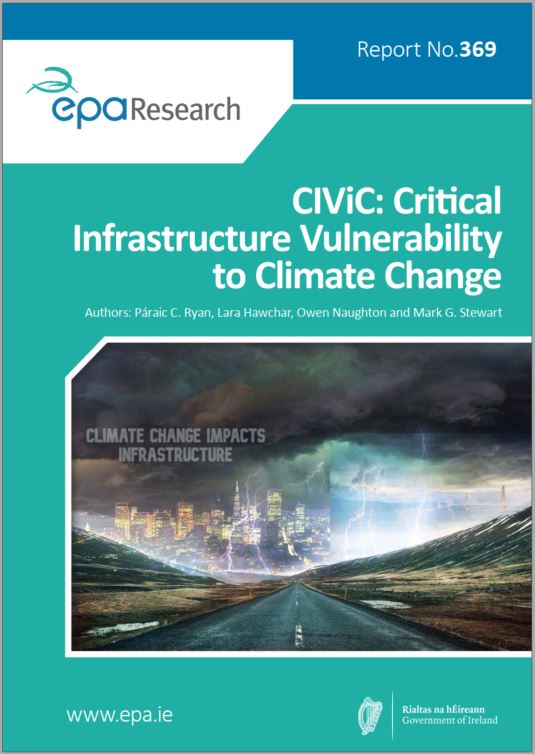Research 369: CIViC: Critical Infrastructure Vulnerability to Climate Change
Authors: Páraic C. Ryan, Lara Hawchar, Owen Naughton and Mark G. Stewart
Summary: Modern society relies on the effective functioning of critical infrastructure networks to provide public services, enhance quality of life and spur sustainable economic development. Part A of this report presents a framework and analysis aimed at identifying potential risks for the four main critical infrastructure sectors. Part B of the report was applied to part of the energy sector as an illustrative case study.

Project Highlights
Watch the project highlights video
Identifying Pressures
Modern society relies on the effective functioning of critical infrastructure networks to provide public services, enhance quality of life and spur sustainable economic development. Thus, the critical infrastructure constructed today must be capable of operating decades into the future. The Intergovernmental Panel on Climate Change (IPCC) has identified the “breakdown of infrastructure networks and critical services” as a key climate change risk. Consequently, it is vital that we develop a robust understanding of the climate change risks for our critical infrastructure. This is the first step in developing feasible and cost-effective climate adaptation strategies. Failure to do so is likely to result in significant opportunity costs. In this context, the CIViC project developed climate change risk analysis frameworks and conducted analysis for Irish critical infrastructure on two levels: (1) a high-level risk screening approach was used to analyse Ireland’s four critical infrastructure sectors and (2) a more detailed fully quantitative risk approach was applied to the energy sector. Results indicate that, while risk screening is useful in identifying potential risks, fully quantitative risk analysis is required to develop cost-effective climate adaptation strategies for Ireland’s critical infrastructure.
Informing Policy
Critical infrastructure is identified as one of four key themes under Ireland’s National Adaptation Framework (NAF). Vulnerability assessment, risk analysis and adaptation decision support tools are identified in the NAF as key components of “a new framework for delivering climate resilience”. The importance of climate risk analysis was highlighted in the IPCC Fifth Assessment Report and is recognised under the United Nations Framework Convention on Climate Change, including its Paris Agreement. The IPCC defines climate change risk as the integration of hazard, vulnerability and exposure. This definition formed the basis of the climate risk analysis frameworks developed in the CIViC project. It was applied to both the high-level risk screening assessment and the detailed quantitative risk assessment of critical infrastructure. It is hoped that these CIViC risk analysis frameworks and assessments, which were applied in part in the recent Climate Change Adaptation Plan for Transport Infrastructure, will also help to improve future iterations of other sectoral adaptation plans under the NAF.
Developing Solutions
Three main steps are required to help ensure the long-term resilience of Irish critical infrastructure under future climatic conditions: (1) identify potential climate risks, (2) quantify the magnitude of these risks and impacts, and (3) develop cost-effective climate adaptation strategies to mitigate unacceptably high risks. Part A of the CIViC report presents a framework and analysis, aimed at identifying potential risks for the four main critical infrastructure sectors (transport, energy, water and ICT). This was achieved through a GIS-based high-level climate change risk assessment. While this semi-quantitative risk screening is useful, it does not quantify the magnitude of projected impacts, or provide sufficient detail to develop adaptation actions for large-scale infrastructure networks. This can however be achieved through the more informative fully quantitative risk framework developed in Part B of the report, which was applied to part of the energy sector as an illustrative case study. Although much more resource intensive, this analysis was successful in quantifying risks and developing a cost-effective climate adaptation strategy that reduced the projected impact of climate change on timber power pole networks.
https://www.epa.ie/media/epa-2020/research/epa-funded-research/Twitter_369.jpg